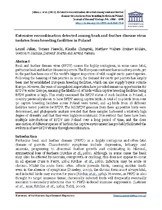Extensive recombination detected among beak and feather disease virus isolates from breeding facilities in Poland
Date
2013Author
Julian, Laurel
Piasecki, Tomasz
Chrzastek, Klaudia
Walters, Matthew
Muhire, Brejnev
Harkins, Gordon William
Martin, Darren Patrick
Varsani, Arvind
Metadata
Show full item recordAbstract
Beak and feather disease virus (BFDV) causes the highly contagious, in some cases fatal,
psittacine beak and feather disease in parrots. The European continent has no native parrots, yet
in the past has been one of the world’s biggest importers of wild-caught exotic parrot species.
Following the banning of this practice in 2007, the demand for exotic pet parrots has largely been
met by established European breeding facilities, which can also supply buyers outside Europe.
However, the years of unregulated importation have provided numerous opportunities for BFDV to
enter Europe, meaning the likelihood of birds within captive breeding facilities being BFDV
positive is high. This study examined the BFDV status of such facilities in Poland, a country
previously shown to have BFDV among captive birds. A total of 209 birds from over 50 captive
breeding facilities across Poland were tested, and 43 birds from 18 different facilities tested
positive for BFDV. The full BFDV genomes from these 43 positive birds were determined, and
phylogenetic analysis revealed that these samples harboured a relatively high degree of diversity
and that they were highly recombinant. It is evident that there have been multiple introductions of
BFDV into Poland over a long period of time, and the close association of different species of
birds in the captive environment has probably facilitated the evolution of new BFDV strains
through recombination.

